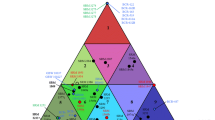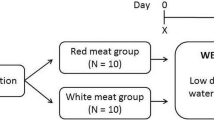Abstract
Whether dietary exposure to nitrate metabolites is detrimental or beneficial to human health has long been a matter of controversy. In spite of no consistent epidemiological evidence, nitrate metabolites are associated with the formation of carcinogenic-nitrosamines and gastric cancer. Furthermore, recent studies demonstrate that ingested nitrate plays a role in host defence against gastrointestinal pathogenic bacteria.
Analytical values of nitrate content in foods are essential for estimating nitrate intake. The analytical process is of paramount importance for assessing human nitrate exposure and for establishing a link between these exposures and the current and future observed health effects. Therefore, the quality assurance of the measurement process is crucial to obtaining reliability, comparability and traceability of results.
Certified Reference Materials (CRM) should play a role in the consistency of the measurement process. However, the availability of nitrate CRMs is still poor. When food monitoring is demanded, an approach could be to use In House Reference Materials (IHRM), prepared at a high metrological level, and all preparation steps should be quality driven.
IHRMs were prepared, and available CRMs were used to provide traceability of the process. The homogeneity of IHRM was evaluated using an appropriate statistical design. The stability was monitored using an isochronous method. The material shelf life and storage conditions are presented.
HPLC was optimised for the determination of nitrates in four vegetable categories. When a suite of IHRMs were used, the response of the HPLC system was linear over the range 1 to 8 mg L–1. The detection limit for these compounds was 0.2 μg L−1 and the determination limit 1.2 μg L−1.
The relationship between measurement uncertainty and critical points of the analytical process is presented. The differences in observed relative uncertainty between food categories could reflect current limitations in the food matrix reference materials.








Similar content being viewed by others
References
Meah M, Harrinson N, Davies A (1994) Food Addit Contam 11:519–532
Swann P (1975) J Sci Food Agric 26:1761–1770
Tricker A (1997) Eur J Cancer Prev 6:226–268
Archer D (2002) J Food Protect 65:872–875
Laurauche M, Anton PM, Garcia-Villar R, Theodorou V, Frexinos J, Bueno L, Fioramonti J (2003) Brit J Nutr 89:777–786
Vaessen H, Schothorst R (1999) Food Addit Contam 16:181–188
World Health Organisation (2002) Technical Report Series 913:i-viii, 1–153
EUR 17637 (1997) Reports on tasks for scientific cooperation (SCOOP). Directorate-General III Industry, Brussels
Ysart G, Miller P, Barret G, Farrington D, Lawrance P, Harrison N (1999) Food Addit Contam 16:521–532
Petersen A, Stoltze S(1999) Food Addit Contam 16:291–299
Borawska M, Markiewicz R, Witkowska A (1998) Eur J Clin Nutr 52:489–493
Dich J, Järvinen R, Knekt P, Penttilä PL (1996) Food Addit Contam 13:541–552
Institute for Reference Materials and Measurements (2003) Reference Materials Catalogues. http://www.irmm.jrc.be/mrm.html. Cited 5 Dec 2003
CORDIS (Community Research and Development Information Service) (2003) Homepage. http://www.cordis.lu/en/home.html. Cited 5 Dec 2003
Oliveira L, Palla-Garcia M, Amaral E, Bartolo M, Vargas C (1997) Actas do 3º Encontro de Química dos Alimentos, Faro, Portugal, pp 46
Alvito P, Oliveira L, Capucho S, Alcobia D, Reis M, Fonseca C, Vasconcelos L, Calhau M (2003) Strategies for Safe Food, 24–26 Sept 2003, Brugge, Belgium, pp 408–411 (ISBN 90-804957-2-7)
IUPAC (2001) Pure Appl Chem 73(4):667–683
Eurachem-CITAC (2000) Quantifying uncertainty in analytical measurement, 2nd edn. Eurachem LGC, Teddington, UK
International Organization for Standardization (1999) ISO Guide 35, 3rd Draft. ISO, Geneva, Switzerland
Cortez L, Kramer K (2003) New training tool for use of laboratory reference materials. Ninth International Symposium on Biological and Environmental Reference Materials (BERM9), 15–19 June 2003, Berlin, Germany, Poster A17
International Organization for Standardization (1994) ISO 5725-1:1994 /Cor 1:1998; ISO 5725-2:1994 /Cor 1:2002; ISO 5725-3:1994 /Cor 1:2001; ISO 5725-4:1994; ISO 5725-6:1994 /Cor 1:2001, Geneva, Switzerland
International Organization for Standardization (1998) ISO 5725-5:1998, Geneva, Switzerland
Bonas G, Zervou M, Papaeoannou T, Lees M (2003) Accredit Qual Assur 8:101–107
Fearn T, Thompson M (2001) Analyst 126:1414–1417
Cheng CF, Tsang CW (1998) Food Addit Contam 15:753–758
Reece P, Hird H (2000) Food Addit Contam 17:219–222
Zhong W, Hu C, Wang M (2002) Food Addit Contam 19:1125–1129
Merino L, Edberg V, Fuchs G, Aman P (2000) J AOAC Int 83:365–375
Eurachem/CITAC (2003) Homepage. http://www.measurementuncertainty.org/. Cited 11 Dec 2003
International Organization for Standardization (1996) ISO 11095:1996. ISO, Geneva, Switzerland
van der Veen A, Linsinger T, Pauwels J (2001) Accredit Qual Assur 6:26–30
International Organization for Standardization, ISO (2000) Quality management systems-Fundamental and vocabulary. ISO, Geneva, Switzerland
International Organization for Standardization, ISO (1993) International vocabulary of basic and general terms in metrology, 2nd edn. ISO, Geneva, Switzerland
Dybkaer R (2003) Accredit Qual Assur 8:46–52
Bièvre P, Kaarls R, Pieser H, Rasberry S, Reed W (1996) Accredit Qual Assur 1:3–13
Vaz D, Castanheira I, Fino H, van der Veen A (2000) OIML Bull 51:8–12
Anglov T, Petersen I, Kristiansen J (1999) Accredit Qual Assur 4:504–510
Acknowledgements
The authors wish to thank the staff of the Food Composition Laboratory for technical assistance, Dr. Ricardo Diogo for manuscript revision, and Dr. Maria Antónia Calhau, Head of Department, for her helpful comments, critical reading of the manuscript, and encouragement for this work.
Author information
Authors and Affiliations
Corresponding author
Rights and permissions
About this article
Cite this article
Castanheira, I., Oliveira, L., Valente, A. et al. The need for reference materials when monitoring nitrate intake. Anal Bioanal Chem 378, 1232–1238 (2004). https://doi.org/10.1007/s00216-003-2382-3
Received:
Revised:
Accepted:
Published:
Issue Date:
DOI: https://doi.org/10.1007/s00216-003-2382-3




